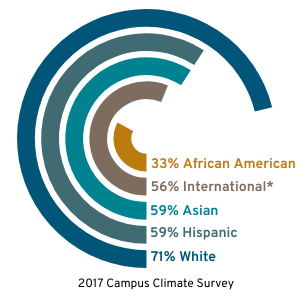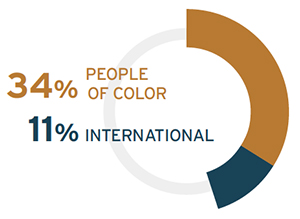Opportunities And Challenges
American University is building on earlier progress made toward reflecting and valuing diversity—goals laid out in a previous strategic plan in 2008. In 2016, under the leadership of former President Neil Kerwin, the university put forth a five-point diversity and inclusion plan which led to the creation of new councils, hiring and training programs, as well as centers of scholarship and majors.
At that juncture, a thoroughgoing examination of our efforts led to the assessment that the institutions, policies, and practices that could respond to inequities were considered at best inconsistent and opaque; at worst, biased. That assessment summarized a number of opportunities and challenges the university faced with respect to diversity, equity, and inclusion.
Where We Were
AU engaged in a thorough review and analysis of our environment and practices. Existing survey data and interviews provided important input for this assessment of where we were, and where we needed to go.
Key observations and findings indicated in stark terms the work we had to do:
More students of color experienced bias and felt alienated and unsafe, compared to white peers.
- Only 33 percent of African American students said they felt included on campus, compared to 71 percent of white students and less than 60 percent each of Hispanic, Asian, or international* students. Too few students from other segments of people of color are enrolled at AU to call out in these statistics.(Source: 2017 Campus Climate Survey).
- Students reported a lack of comfort in classrooms and with faculty, citing racial and gender bias, as well as a consistent pattern of derogatory comments directed at students of color.
- First-year students who identified as minorities did not feel as comfortable with faculty and academic advisors as their non-minority student counterparts. (Source: 2016 National Survey of Student Engagement)
- Students of color felt less physically and emotionally safe than their white counterparts, and saw few spaces designed by and for underrepresented students to hold meetings, to study together, and to socialize.
Fewer students of color and international* students said they felt included on campus, compared to white peers.
* International students are not US citizens or permanent residents, and instead are here on a student or other non-immigrant visa.

Institutional systems, policies, and practices were considered at best inconsistent and lacking transparency; at worst, biased.
- Majorities of students of all races said that, in responding to troubling situations around discrimination or bias, AU was not responsive to student concerns. (Source: 2017 Campus Climate Survey).
- Students said they wanted more clarity about how to navigate institutional policies. They also sought to better understand how incidents of bias, discrimination, and harassment were handled.
- The institutional policies and practices for hiring especially needed to be further examined to determine how practices were impacting recruitment outcomes for staff and faculty appointments.
Training programs to develop cultural competence and mitigate bias were many and varied; most were voluntary, and their effectiveness had not been adequately demonstrated.
- Programs at AU had primarily been offered by Human Resources, the Center for Teaching, Research, and Learning, and the Center for Diversity and Inclusion. All training programs were optional, excluding the required compliance course focused on Preventing Discrimination and Sexual Violence. Summer orientation for incoming students included a diversity and inclusion session, which 89 percent of first-year students took in the summer of 2017. New faculty orientation in 2018 included a session on inclusive pedagogy.
- During the past year, bookended by those orientations for new students and faculty, there was a major expansion of diversity course offerings through Human Resources as well as through the Office of the Provost; between the two units, nearly 20 new trainings were added.
- However, no comprehensive inventory of training programs existed, and there was no consistent framework within which training programs were being developed, assigned as expectations, or measured for effectiveness.
Diversity across all levels of the institution grew incrementally over the course of those few years, but inequities and gaps persisted for racial minorities, acutely so for African American/black members of the community.
- Students reported that it was important to see themselves reflected in the faculty and curriculum to create a sense of belonging and inclusiveness.
- Compositional diversity of students and faculty in fall 2017:

Students
- 13.6% Hispanic/Latino
- 9.3% African American
- 6.5% Asian American
- 4.5% Multiracial
- 0.2% American Indian/Alaskan Native
- < 0.1% (5) Native Hawaiian

Faculty
- 7.8% Asian American
- 5.8% African American
- 5.5% Hispanic/Latino
- 0.1% Mulitracial
